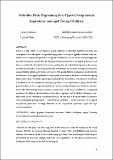Por favor, use este identificador para citar o enlazar a este item:
http://hdl.handle.net/10261/35369COMPARTIR / EXPORTAR:
 SHARE
BASE SHARE
BASE
|
|
| Visualizar otros formatos: MARC | Dublin Core | RDF | ORE | MODS | METS | DIDL | DATACITE | |

| Título: | Girls like Pink: Explaining Sex-Typed Occupational Aspirations amongst Young Children |
Autor: | Polavieja, Javier CSIC ORCID; Platt, Lucinda | Palabras clave: | Gender Segregation Occupational Aspirations Children Socialization Agency Personality Traits Mechanisms British Household Panel Survey |
Fecha de publicación: | 14-oct-2010 | Citación: | UFAE and IAE Working Papers ; 844.10. | Resumen: | There is a high degree of sex-typing in young children's occupational aspirations and this has consequences for subsequent occupational segregation. Sociologists typically attribute early sex- differences in occupational preferences to gender socialization. Yet we still know surprisingly little about the mechanisms involved in the intergenerational transmission of sex-typical preferences and there is considerable theoretical controversy regarding the role of individual agency in the process of preference formation. This study analyzes the determinants of sex-typed occupational aspirations amongst British children aged between 11 and 15. We specify different mechanisms involved in the transmission of sex-typical preferences and propose an innovative definition of individual agency that is anchored in observable psychological traits linked to self-direction. This allows us to perform a simultaneous test of socialization and agency predictors of occupational sex-typing. We find that parental influences on occupational preferences operate mainly through three distinctive channels: 1) the effect that parental socio-economic resources have on the scope of children's occupational aspirations, 2) children's direct imitation of parental occupations, and 3) children's learning of sex- typed roles via the observation of parental behavior. We also find a strong net effect of children's own psychological predispositions -self-esteem in particular- on the incidence of sex-typical occupational preferences. Yet large differences in the occupational aspirations of girls and boys remain unexplained. | Descripción: | JEL CODES: J13; J16; J24; Z13. | Versión del editor: | http://pareto.uab.es/wp/2010/84410.pdf | URI: | http://hdl.handle.net/10261/35369 |
| Aparece en las colecciones: | (IAE) Informes y documentos de trabajo |
Ficheros en este ítem:
| Fichero | Descripción | Tamaño | Formato | |
|---|---|---|---|---|
| 84410.pdf | 230,68 kB | Adobe PDF |  Visualizar/Abrir |
CORE Recommender
Page view(s)
281
checked on 22-abr-2024
Download(s)
1.133
checked on 22-abr-2024
Google ScholarTM
Check
NOTA: Los ítems de Digital.CSIC están protegidos por copyright, con todos los derechos reservados, a menos que se indique lo contrario.
